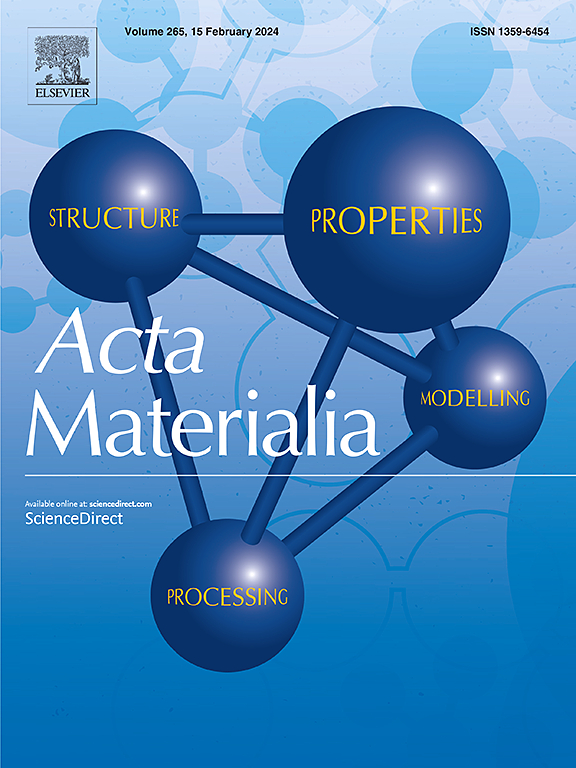中锰钢中速率相关的韧脆转变
IF 8.3
1区 材料科学
Q1 MATERIALS SCIENCE, MULTIDISCIPLINARY
引用次数: 0
摘要
中锰钢因其优异的拉伸性能和丰富的变形机制而受到广泛关注。本研究报告了在应变速率为10-6 s-1到101 s-1的情况下,应变速率相关的韧性-脆性转变现象,其中均匀伸长率从10-6 s-1的10%急剧增加到100 s-1的50%。换句话说,这种MMS在低应变率下表现出脆性,但在高应变率下变得延展性。为了揭示这一不寻常现象的起源,研究人员对不同应变速率下的显微组织演变、断裂行为和应变非均质性进行了综合表征。尽管微观组织演化相似,但断裂形态从低应变速率下的准解理和晶间裂纹脆性断裂过渡到高应变速率下的韧窝韧性断裂。在低应变速率下,强而脆的新鲜马氏体和柔软的奥氏体基体导致较高的应变非均质性,而在高应变速率下,由于新鲜马氏体的塑性变形,应变不相容得到很大程度的缓解。在相同的MMS上,预先引入新鲜马氏体和回火马氏体的进一步拉伸试验强调了间隙碳溶质在控制速率相关的韧脆转变中的关键作用。原子探针断层扫描发现,在不同应变速率下,新鲜马氏体中碳团簇的差异表明碳阻力对位错的激活作用。碳阻效应与应变速率成反比,影响了新马氏体的变形能力,导致了应变速率相关的韧脆转变现象。本文章由计算机程序翻译,如有差异,请以英文原文为准。


Rate-dependent ductile-brittle transition in a Medium Mn steel
Medium Mn steels (MMS) have received significant attention owing to their excellent tensile properties and rich deformation mechanisms. This work reports a strain rate-dependent ductile-brittle transition phenomenon in strain rate regime of 10–6 s-1 to 101 s-1, where uniform elongation dramatically increases from ∼10 % at 10–6 s-1 to ∼50 % at 100 s-1. In other words, this MMS exhibits brittleness at a low strain rate but becomes ductile at a high strain rate. To unveil the origin of this unusual phenomenon, comprehensive characterizations focusing on microstructural evolution, fracture behavior, and strain heterogeneity at various strain rates have been carried out. Despite similar microstructural evolutions, the fracture morphology transits from brittle fracture featuring quasi-cleavage and intergranular cracks at low strain rate to ductile fracture featuring dimples at high strain rate. Strong but brittle fresh martensite and soft austenite matrix lead to higher strain heterogeneity at low strain rate, while strain incompatibility is largely alleviated due to plastic deformation of fresh martensite at high strain rate. Further tensile tests on the same MMS with pre-introduced fresh martensite and tempered martensite highlight the critical role of interstitial carbon solutes in governing the rate-dependent ductile-brittle transition. As identified by atom probe tomography, the difference in carbon clusters in fresh martensite at different strain rates indicates the activation of carbon drag effect on dislocations. The carbon drag effect is inversely proportional to strain rate, which is believed to affect the deformability of fresh martensite, leading to the strain rate-dependent ductile-brittle transition phenomenon.
求助全文
通过发布文献求助,成功后即可免费获取论文全文。
去求助
来源期刊

Acta Materialia
工程技术-材料科学:综合
CiteScore
16.10
自引率
8.50%
发文量
801
审稿时长
53 days
期刊介绍:
Acta Materialia serves as a platform for publishing full-length, original papers and commissioned overviews that contribute to a profound understanding of the correlation between the processing, structure, and properties of inorganic materials. The journal seeks papers with high impact potential or those that significantly propel the field forward. The scope includes the atomic and molecular arrangements, chemical and electronic structures, and microstructure of materials, focusing on their mechanical or functional behavior across all length scales, including nanostructures.
 求助内容:
求助内容: 应助结果提醒方式:
应助结果提醒方式:


